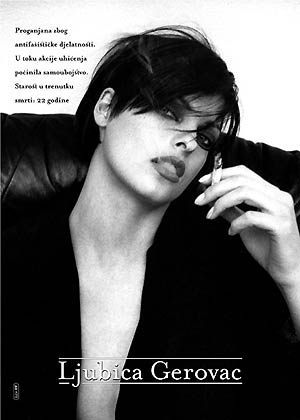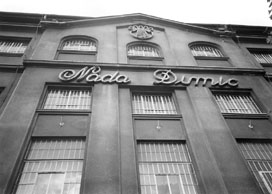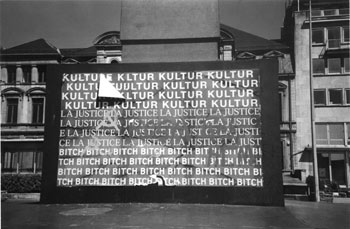| Nata╣a IliŠ & Dejan Kr╣iŠ |
|
| Political Practices
of Art |
Chances for Alternative Culture
In regard to cultural production, the term 'alternative'
is usually linked to notions such as anti-art, avant-garde,
neo-avant-garde, contra-culture, to everything and anything
which is different in form and content, progressive, radical,
which gets out of the mainstream and opposes the establishment,
the traditional bourgeois high culture. But in today's circumstances
of culturalising everything, in a situation when every 'avant-garde'
or 'subversive' act is immediately absorbed as a fashion,
an exclusively cultural and temporary alternative, there is
no alternative culture. Alternative culture existed when there
still were alternative ideas about the order of society, ideas
of alternative politics. Or, it might be better to say that
alternative culture is to be articulated only if there is
a policy that articulates the alternative to the truly existent
capitalism. In the current situation cultural and artistic
production can remain alternative not by the virtues of new,
different, unusual forms or ways of expression, but exclusively
in a political sense.
In its heroic period of 1970s and 1980s, the alternative
cultural movements in Yugoslavia acted against official institutions
or at least apart from them. Self-organising and activism
were politically engaged, but not as 'a battle against the
darkness of Communist totalitarianism', but, paradoxically
for the state whose official ideology was 'self-management',
as a fight for complete self-realisation of individuals and
culture, against the real bureaucratic limitations. Alternative
cultural movement was indeed taking socialist ideology more
seriously than the cynical political Úlite in power did. Paradoxically,
deeply politicised, alternative, sub-cultural movements of
'70s and '80s in the East actually disintegrated at the moment
of their supposed triumph - with the introduction of parliamentary
democracy and the 'return of capitalism'.
Instead of ' the normal' integration of the previously alternative
culture into the market mainstream, a process started in Croatia
in the late '80s, in the '90s we had witnessed its complete
breakdown. With new nationalist government, within the general
suffocation of all liberal-democratic tendencies, but also
due to the brutal early capitalistic economy, the institutional
framework through which 'other', 'alternative' cultural scene
managed to act, was completely destroyed.
Within the independent Croatian civil scene in the '90s, often
called the alternative scene(1), the notion of alternative
was used differently in two broad periods. The first one,
in accordance to the general regression, characteristic of
the period of the Croatian Democratic Community party's
rule, is actually a continuation of '70s ideology that perceives
alternative culture as the low opposition to high, Úlite,
institutional culture. That scene, roughly identified with
eco/punk/hardcore/anarcho groups and movements, really was
marginal and marginalised, completely outside of the funding
system, which it had slowly entered only after the establishment
of the Open Society Institute (OSI) in Croatia in 1994.
In the second period, the alternative ceased to be synonymous
with the marginal and the sub-cultural and it developed specific
political meanings, regularly strongly based in ethical demands
for non-violence, equality, multi-ethnicity, non-hierarchical
structures, etc. Unfortunately, OSI-Croatia mostly held onto
the liberal, bourgeois mainstream position that had not been
quite receptive for politicised, alternative cultural and
political praxis. The leading people of OSI Croatia did not
have a clear cultural policy, and starting from their cultural-Úlite
positions and the political phantasm about local liberals
being capable of winning the elections, they perceived the
alternative scene as something necessary, yet unwelcome. They
hardly acknowledged or financially supported alternative culture,
and when they did, it was often by miserable funds and under
humiliating conditions. Amongst the leading people of OSI
Croatia, the alternative in the culture was perceived as a
system of parallel institutions that were not nationalistic
or statehood-oriented, but their activities were limited to
fill in the gaps left open by the state and its conservative
institutions.
Therefore, in Croatia of the '90s, the real alternative had
been born out of resistance to Soros cultural phantasms, as
well as to state phantasms; out of the critique of nationalistic
politics and culture, but also in resistance to parliamentary
opposition that had not for a second dared to seriously question
the broader ideological framework and rhetoric of Tuman's
rule.
Subversive strategies of Sanja IvekoviŠ
Amongst the very few contemporary Croatian art practices
that are close to the ideological position that defines itself
as alternative, the most consistent is without a doubt the
art practice of Sanja IvekoviŠ. With her works in the '90s
the artist had tried to reply to the intellectual urgency,
which is even more dramatic when considering the circumstances
under which those performing 'the social function of intellectuals'
have mobilised extreme right ideologies. Many of these works
were realised in various models of collaboration with organisations
that emerged within a broader context of the alternative scene,
while official art institutions were involved in the processes
of its mediation. The production and reception of her artistic
projects has been outlining the sliding terrain of the transformation
of traditional political art into political practices of art.
It also includes all the uncertainties and shifting positions
of the attempt to pose the questions whose answers cannot
be announced in advance, but can only develop through a series
of failures. It is an effort not just to illustrate the political
thesis, thus making it clear to those who already know it,
but to include art into the political praxis, form new ideas
and spread them into society.
The struggle for uniqueness of the national culture fought
by right wing intellectuals has been realised as a struggle
against left cultural hegemony, interpreted as the foreign,
external element that threatens the purity of the national
culture/national identity. A vital part of the project of
cleaning up the national culture has been suppressing the
important part of history and producing a silent collective
amnesia.

Sanja IvekoviŠ, Gen XX, 1997-2001 |
Sanja IvekoviŠ's project Gen XX has been realised
as advertisements published in various magazines. The women
in the photographs are professional models whose faces are
familiar to the contemporary audience, while the text accompanying
the photos presents National Heroines known to the generations
that lived in socialist ex-Yugoslavia, but have been completely
erased from the contemporary collective consciousness.
The manoeuvre that Sanja IvekoviŠ performs within the Gen
XX media action consists of appropriating the media talk
and subverting it by its own means. Using the media is always
a manipulation, a technical treatment of the given material
with a particular goal in mind. When the technical intervention
is of immediate social relevance, manipulation is a political
act (which it is by default within the media industry). Gen
XX turns this commonly accepted fact into its advantage,
appealing to people's sophistication, addressing a 'target
group' that takes pleasure in being taken seriously and should
not be left to advertising.(2)
Gen XX gives lessons in both history and media dwelling
in the imaginary space that shapes the formation of the public.
Its subversive tactics do not reside in the practice of provocation
but in its accommodation to the social codes and conventions
of everyday life informed by mass culture.
It is a certain translation from a specialised language into
the media code, re-translated by media recipients into their
own language of the every-day. The effectiveness of its communication
strategy consists of this translation based on the analysis
of the moment of performance and transmission of knowledge
in relation to the moment of the conception and of the research
itself.

Sanja IvekoviŠ, SOS Nada DimiŠ,
2000 |
The urban intervention SOS Nada DimiŠ was realised
in June 2000, at a time when bankruptcy cases have been heading
the news and the optimism caused by the change of the government
a few months earlier(3) did not drain out completely yet.
The work refers to the National Heroine Nada DimiŠ, a real
person killed in World War II for her anti-fascist activities,
but also to the factory named after her. The textile factory,
which traditionally employs mostly women, had been successfully
functioning under the name Nada DimiŠ throughout the socialistic
decades, but went into bankruptcy as Endi International,
which is the title it obtained in the '90s.
Renovation and re-lighting of the neon sign Nada DimiŠ at
the factory's fašade, in the situation when the state bureaucratically
administrated the bankruptcy procedure and the fates of hundreds
of pauperised, mostly middle-aged women who were about to
lose their jobs, was a highly symbolical act. To let the light
shine on the factory and its troubled workers functioned not
only as a reminder on the times when brutalities of the market
economy were not accepted as a natural and objective state
of things that can not be altered, but also as a call and
warning.
At the same time it was about a beautiful logo whose neon
lettering functioned as a personal signature, an unique and
proper sign, an authorisation of legal validity that links
the factory's name to the real person, Nada DimiŠ. To light
the logo with the name of the heroine forgotten and turned
into a brand name is not only about re-establishing her both
as a person and a role model in the male-dominated society,
but also about urban landscape appreciation. It shows a certain
sensitivity for urban layers of the past so crudely dismissed
in the renovations undertaken during the '90's in most of
the Eastern European 'metropolisis'.
Rosa Luxemburg at the Heart of Capitalism
Sanja IvekoviŠ's biggest public art project so far, Lady
Rosa of Luxembourg, shows many of the artist's preoccupations
expressed in her earlier works. The work also testifies to
a certain shift, in many ways connected to the different context
of the Western social and art system. Lady Rosa of Luxembourg
was realised in the spring of 2001 within the exhibition Luxembourg,
Les Luxembourgeois that intended to define and question
the issue of the national identity of Luxembourg. The exhibition
was organised by MusÚe d'Histoire de la Ville de Luxembourg.
Like Gen XX and Nada DimiŠ File, it also links
the issues of social remembrance and amnesia to the women's
position in the society. The project has been realised as
a copy of the Luxembourg monument GŰlle Fra (Golden Lady),
the strong national symbol of Luxembourg's independence and
resistance erected in commemoration of the victims of World
War I.
The work was first conceived during Manifesta 2 in Luxembourg
in 1997, when the artist proposed to place the statute of
GŰlle Fra in front of the women's shelter during the
duration of the exhibition. Since it was not possible to realise
this, Sanja IvekoviŠ initiated an international project (Women's
House), which was developed in close collaboration with
women's non-government organisations, shelters for women victims
of domestic violence and women who sought help in shelters
in Zagreb and Luxembourg. The artist exhibited plaster casts
of the heads of the women with whom she had been working in
shelters, mimicking traditional high-art exhibition set up
and at the same time elevating anonymous traumatic experience
to the level of universal social relevance.
The original monument of GŰlle Fra, dating from 1920's,
represents an elegant female figure standing at the high obelisk,
draped in clothes through which the outlines of her body are
clearly visible. As such, it belongs to the corpus of monuments
developed during the French Revolution and has become representative
for forms of political constitution and political iconography,
characterised by an allegorised femininity that signifies
freedom, the Republic, as well as the nation or that upon
which a nation's self-understanding can be grounded, that
is, arts and sciences.
The replica was staged not far from the original monument,
from which it differs not only in the materials used (golden
polyester for the figure and wood and iron for the obelisk
and base), but also in a few other important details. The
female figure is clearly pregnant, the original captions on
the monument's base are replaced by words in French (le rÚsistance,
la justice, la libertÚ, la indÚpendence), German (Kitch, Kultur,
Kapital, Kunst) and English (whore, bitch, Madonna, virgin),
and the Golden Lady is subtly renamed to Rosa Luxemburg
and thus moved from the abstract allegorical context into
concrete historical circumstances.
Lady Rosa of Luxembourg was installed on 31st March
2001 and in the weeks to follow it had triggered a violent
set of polemics within the Luxembourg's media. At certain
moments even the question of resignation of the Luxembourg's
Minister of Culture, who had been against the calls to demolish
the monument, had been raised, and before the summer started
press clippings had filled several hundreds pages. The polemic
started when anti-fascists veterans and liberal-national politicians
and men of prominence proclaimed the newly erected, temporary
monument to be blasphemy that makes a mockery out of the Luxembourg
resistance and its victims in both world wars. Strangely enough,
it seems that the most violent attacks were not provoked by
the figure of the pregnant woman, but by the text in three
languages. At the beginning, most photos in the press had
shown only the monument's base with the text, while the figure
of the pregnant woman at the top of the obelisk had often
not been represented at all. What is it about the text by
Sanja IvekoviŠ that provoked such strong reactions? Or maybe
the text had served just as an excuse for the aggression whose
real object is a golden woman whose blatant pregnancy insults
not only the sophisticated aesthetic feelings, but also the
national values represented by allegorical feminine?
The text at the monument's base alludes the complex and problematic
issue of language as the ground for a national identity of
Luxembourg, but it also points towards the entanglement of
the modern construction of the ostensibly natural two sexes
and the construction of the modern nation-state. The transitions
between culture, politics and political representations are
fluid and the political is always already determined by that
with which it is supposed to have nothing to do, and the text
quite clearly exposes the problematic 'naturalness' of the
national monument.

Sanja IvekoviŠ, Lady Rosa of Luxemourg,
2000 |
The English text locates stereotypes about women (Madonna,
whore, bitch, virgin), the French words (le rÚsistance, la
justice, la libertÚ, la indÚpendence) point towards the realm
of political values that the feminine figure allegorically
represents while in reality women had been excluded from them,
while the German text (Kitsch, Kultur, Kapital, Kunst) comments
the cultural production and the production of culture that
lies at the very base of such a constellation.
By naming her sculpture after Rosa Luxemburg, the artist unmasks
not only the fact that women are symbolically constructed
as the symbolic bearers of national history (but at the same
time they are denied any direct relation to national agency),
but it also affirms the revolutionary politics of Rosa Luxemburg
and questions the very notion of national identity. Rosa Luxemburg,
a 'left terrorist', as she was proclaimed in one of the angry
letters in Luxembourg's daily press, deeply annoys the myth
of capitalist ways of production, and capitalism as a social
order supposedly being capable to reproduce without non-economical
oppressions. As a pregnant woman, she threatens to affect
the framework of the collective memory that consists of things
which are 'always already' understandable and reproducible,
without having to be made explicit or explained in words.
Her words 'Today we can seriously set about destroying
capitalism once and for all' are exactly those that are
not to be heard in today's Luxembourg, the embodiment of smooth
economical functioning and order, just as they were not to
be heard in Europe of 1919.
Judging by the reactions, to erect this public monument is
an act just as serious as it was at the time when the original
monument had been erected, even more so when erected by the
artist who is also an Other - woman, artist, feminist, coming
from the Balkans, from a country of doubtful democratic traditions
- an act that seriously challenges the aseptic (multi)cultural
consensus at the heart of Europe.
But the set of polemics also shows how these arguments were
largely ignored and the emphasis generally shifted to less
relevant concerns. An increasing number of leftist intellectuals
and women's groups got engaged in the defence of the temporary
public monument in the name of abstract artistic freedom,
thus excluding most effectively all those unpleasant questions
that the Lady Rosa of Luxembourg tried to open. Such
an approach had situated the whole story within the framework
that the artistic and general community knows how to deal
with, turning it in an 'undemocratic' incident quickly channelled
back into the system. The fact that the system's efficiency
is not to be doubted is best confirmed by the events that
followed after the exhibition closing, when the monument was
finally removed, at the relief of most involved parties.
The show is over, let's get back to more practical things.
Where to place the monument? The Museum had offered the artist
that it will take care of it, asking the artists to donate
it in return. By that time it was quite clear that it is in
the community's best interest to prevent further irritations,
so Museum's officials suggested not to display the monument
until some appropriate exhibition in the future, which the
artist did not accept. Lady Rosa of Luxembourg ended
up in the courtyard of the women's shelter in Luxembourg.
Which, paradoxically, brings us back to the original proposal
of Manifesta 2. But the circumstances are quite different.
Traditional allegorical values of the original female figure
are strongly fixed within its physical existence as an artistic
object. As for its symbolical values, an initiative to legally
endow the state authorities with copyrights over GŰlle
Fra was instigated in the media, ensuring not only the
protection of the highest national values from future blasphemies,
but also its position within the market economy's rules of
the game. And it is quite obvious that the pregnant replica
located in a women's shelter, away from the public eyes, does
not trigger questions of displacement as the original monument
would. Then again, the women's shelter seems to be a place
quite appropriate for it.
1. Projects like Anti-war Campaign Croatia,
pop-political magazine Arkzin, Zagreb Anarchistic movement,
Autonomous Cultural Factory - Attack, festival of alternative
street theatre FAKI, and many other feminist, ecological,
anti-war, anarchistic organisations, groups, initiatives and
movements.
2. Advertisements were published in magazines such as Arkzin,
Kruh i ruże, Zaposlena and Frakcija. They emerged
within the circle of the Zagreb independent civil scene of
the 1990's that accentuated the openness to the Other at the
time of ethnic intolerance, war, violence, and conservative
attacks on gender and sexual rights and freedom until recently
thought of as obtained and unquestionable.
3. In January 2000 a right-wing government in power for a
decade lost the election.
Nata╣a IliŠ: art historian, independent curator and art critic,
founding member of NGO for visual arts What, How & for
Whom.
Dejan Kr╣iŠ: art historian, designer and Editor of design
studio/publishing house Arkzin.
|

